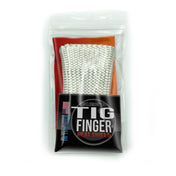If you can tig weld low carbon steel like AISI 1010-1020 you can tig weld 4130 chromoly. These 3 Videos will show the subtle differences
Video #1 TIG Welding Low Carbon Steel Tubing along with Basic TIG Fundamentals
Video #2 TIG Welding 4130 Chromoly Tubing
Video #3 TIG welding Thick 4130 Chromoly with Preheat
Here are the key differences between TIG welding low carbon steel and 4130 chromoly (thickness of .120” and under) that welding students, hobbyists, and professionals should understand:
1. Preheat Requirements
- Low Carbon Steel (e.g., 1018, 1010-1020, A36, mild steel):
- No preheat typically required for thicknesses under .25”.
- Welds are less crack sensitive and more forgiving due to low carbon content.
- 4130 Chromoly:
- Preheat may be recommended starting at .120” thickness, usually around 200–300°F, especially for critical applications (like aircraft frames or racing components). Thicker sections require higher preheat.
- Preheat helps reduce the risk of cracking due to the alloy’s higher hardenability.
2. Filler Metal Selection
- Low Carbon Steel:
- Common fillers: ER70S-2 or ER70S-6.
- Easy to match with the base metal’s mechanical properties.
- 4130 Chromoly:
- Often welded with ER70S-2, a lower-strength filler, to create a more ductile weld.
- Matching 4130 filler can be used but may lead to brittle welds. matching 4130 filler metal is rarely used unless post-weld heat-treatment is also used to stress relieve and to achieve certain weld properties
- For small aircraft or bike frames, ER70S-2 is often preferred for ductility and to avoid cracking.
3. Post-Weld Heat Treatment (PWHT)
- Low Carbon Steel:
- Not typically required. The material doesn’t harden in the heat-affected zone (HAZ).
- 4130 Chromoly:
- PWHT is often recommended for thick or critical parts to relieve residual stress and reduce brittleness.
- For tubing under .120", PWHT may not be necessary, especially if low-strength filler (like ER70S-2) is used and the weld is done carefully.
4. Welding Technique & Heat Input
- Low Carbon Steel:
- Very forgiving with higher heat input.
- Can tolerate wider arc lengths and slower travel speeds.
- 4130 Chromoly:
- Requires tighter arc control and lower heat input to minimize grain growth and HAZ brittleness.
- Best to use short arc length to keep the weld small and minimize distortion.
5. Crack Sensitivity
- Low Carbon Steel:
- Used in general fabrication, not typically for high-stress or structural critical parts.
- Welds are less crack sensitive and more forgiving to technique and preparation.
- 4130 Chromoly:
Often used in aircraft, roll cages, bike frames, and racing chassis where strength and reliability are critical.
- Weld quality, cleanliness, and preparation are more important.
6. Cleaning & Preparation
- Both low carbon steel and 4130 chromoly:
- Should be cleaned to bare, shiny metal before welding (no mill scale, oil, rust, or paint).
- 4130 is more sensitive to contamination, which can lead to cracking.
Understanding these differences ensures better quality welds and helps avoid common problems like cracking or distortion—especially when working with 4130 chromoly on high-performance projects.










